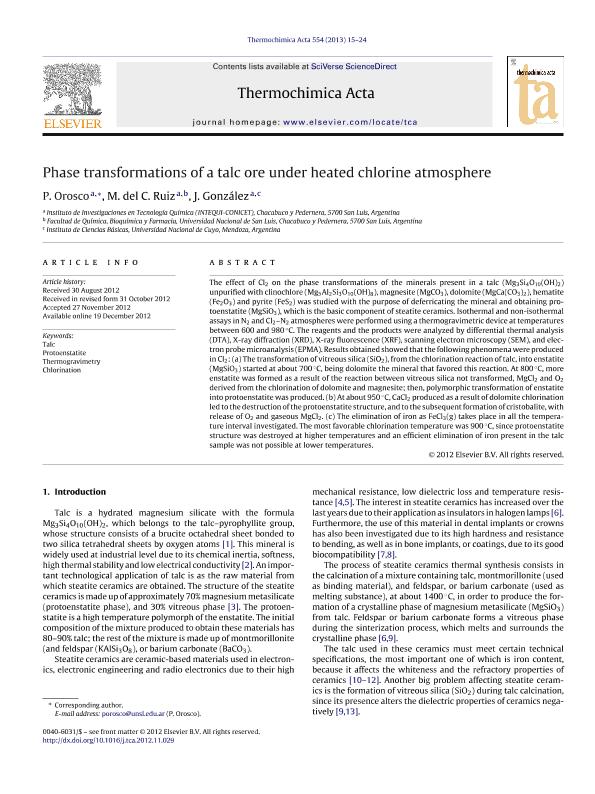Artículo
Phase transformations of a talc ore under heated chlorine atmosphere
Fecha de publicación:
20/02/2013
Editorial:
Elsevier Science
Revista:
Thermochimica Acta
ISSN:
0040-6031
Idioma:
Inglés
Tipo de recurso:
Artículo publicado
Clasificación temática:
Resumen
The effect of Cl2 on the phase transformations of the minerals present in a talc (Mg3Si4O10(OH)2) unpurified with clinochlore (Mg5Al2Si3O10(OH)8), magnesite (MgCO3), dolomite (MgCa(CO3)2), hematite (Fe2O3) and pyrite (FeS2) was studied with the purpose of deferricating the mineral and obtaining protoenstatite (MgSiO3), which is the basic component of steatite ceramics. Isothermal and non-isothermal assays in N2 and Cl2–N2 atmospheres were performed using a thermogravimetric device at temperatures between 600 and 980 °C. The reagents and the products were analyzed by differential thermal analysis (DTA), X-ray diffraction (XRD), X-ray fluorescence (XRF), scanning electron microscopy (SEM), and electron probe microanalysis (EPMA). Results obtained showed that the following phenomena were produced in Cl2: (a) The transformation of vitreous silica (SiO2), from the chlorination reaction of talc, into enstatite (MgSiO3) started at about 700 °C, being dolomite the mineral that favored this reaction. At 800 °C, more enstatite was formed as a result of the reaction between vitreous silica not transformed, MgCl2 and O2 derived from the chlorination of dolomite and magnesite; then, polymorphic transformation of enstatite into protoenstatite was produced. (b) At about 950 °C, CaCl2 produced as a result of dolomite chlorination led to the destruction of the protoenstatite structure, and to the subsequent formation of cristobalite, with release of O2 and gaseous MgCl2. (c) The elimination of iron as FeCl3(g) takes place in all the temperature interval investigated. The most favorable chlorination temperature was 900 °C, since protoenstatite structure was destroyed at higher temperatures and an efficient elimination of iron present in the talc sample was not possible at lower temperatures.
Palabras clave:
CHLORINATION
,
PROTOENSTATITE
,
TALC
,
THERMOGRAVIMETRY
Archivos asociados
Licencia
Identificadores
Colecciones
Articulos(CCT - MENDOZA)
Articulos de CTRO.CIENTIFICO TECNOL.CONICET - MENDOZA
Articulos de CTRO.CIENTIFICO TECNOL.CONICET - MENDOZA
Articulos(CCT - SAN LUIS)
Articulos de CTRO.CIENTIFICO TECNOL.CONICET - SAN LUIS
Articulos de CTRO.CIENTIFICO TECNOL.CONICET - SAN LUIS
Articulos(INTEQUI)
Articulos de INST. DE INVEST. EN TECNOLOGIA QUIMICA
Articulos de INST. DE INVEST. EN TECNOLOGIA QUIMICA
Citación
Orosco, Roberto Pablo; Ruiz Salado, Maria del Carmen; Gonzalez, Jorge Alberto; Phase transformations of a talc ore under heated chlorine atmosphere; Elsevier Science; Thermochimica Acta; 554; 20-2-2013; 15-24
Compartir
Altmétricas




